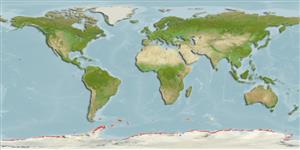Symplectoscyphus cumberlandicus (Jäderholm, 1905)
| Native range | All suitable habitat | Point map | Year 2050 |

|
| This map was computer-generated and has not yet been reviewed. |
| Symplectoscyphus cumberlandicus AquaMaps Data sources: GBIF OBIS |
Upload your photos
Google image |
No photo available for this species.No drawings available for Sertulariidae.
Google image |
No photo available for this species.
Classification / Names Common names | Synonyms | CoL | ITIS | WoRMS
Hydrozoa | Leptothecata | Sertulariidae
Environment: milieu / climate zone / depth range / distribution range Ecology
Sessile; depth range 8 - 195 m (Ref. 7416). Polar
Distribution Countries | FAO areas | Ecosystems | Occurrences | Introductions
Circum-Antarctic.
Length at first maturity / Size / Weight / Age
Maturity: Lm ? range ? - ? cm Max length : 5.0 cm H male/unsexed; (Ref. 7416)
Short description Morphology
5 cm high. Erect stem arising from disk-shaped hydrorhiza. Stem stiff, thickest basally and gradually thinning toward the apex, up to half its length or slightly more polysiphonic, distal part monosiphonic. Branching alternate over irregular distances or quite irregular. Principal branches polysiphonic at their base, the remaining branches are monosiphonic’ (Ref. 7417).
The present fragmented state of the colony does not allow the re-description of its general appearance. The colony has a discoid hydrorhiza and the stem is polysiphonic at least in the first 3 cm (the three basal most fragments of 1.4, 0.8 and 0.8 cm are polysiphonic). Polysiphonic stolons thick, more or less as main stem. Hydrothecae alternately arranged, approximately in one plane, hidden by polysiphonic development at basal part of stem. One hydrotheca per internode. Hydrotheca almost cylindrical, slightly abcaudally directed, adnate to internode for approximately two-thirds of its length. Free portion of adcauline hydrothecal wall slightly convex. Abcauline wall straight or slightly concave, mainly at its distal part. Hydrothecal aperture upwardly directed. Cusps sharp and separated by deep embayments. Rim of hydrothecal aperture with frequent and numerous renovations. Gonothecae oval, inserting at hydrothecal base. Gonothecal wall ringed, with 10 to 12 spirally arranged rings. Apical part of gonotheca with a long tube, widening distally and clearly surpassing the last ring.
Life cycle and mating behavior Maturity | Reproduction | Spawning | Eggs | Fecundity | Larvae
Known with gonothecae in May and August.
Main reference
References | Coordinator | Collaborators
Peña Cantero, A.L., A. Svoboda and W. Vervoort. 2002. (Ref. 7416)
IUCN Red List Status (Ref. 130435: Version 2024-1)
CITES status (Ref. 108899)
Not Evaluated
CMS (Ref. 116361)
Not Evaluated
Threat to humans
Harmless
Human uses
| FishSource |
Tools
More information
Trophic Ecology
Food items
Diet
Food consumption
Ration
Predators
Diet
Food consumption
Ration
Predators
Ecology
Population dynamics
Growth
Age/Size
Length-weight
Length-length
Length-frequencies
Mass conversion
Recruitment
Abundance
Age/Size
Length-weight
Length-length
Length-frequencies
Mass conversion
Recruitment
Abundance
Life cycle
Distribution
Human Related
Aquaculture profile
Stamps, Coins Misc.
Stamps, Coins Misc.
Outreach
Taxonomy
References
Internet sources
BHL | BOLD Systems | CISTI | DiscoverLife | FAO(Publication : search) | Fishipedia | GenBank (genome, nucleotide) | GloBI | Gomexsi | Google Books | Google Scholar | Google | PubMed | Tree of Life | Wikipedia (Go, Search) | Zoological Record
Estimates based on models
Preferred temperature
(Ref. 115969): -1.9 - -0.9, mean -1.4 (based on 116 cells).


